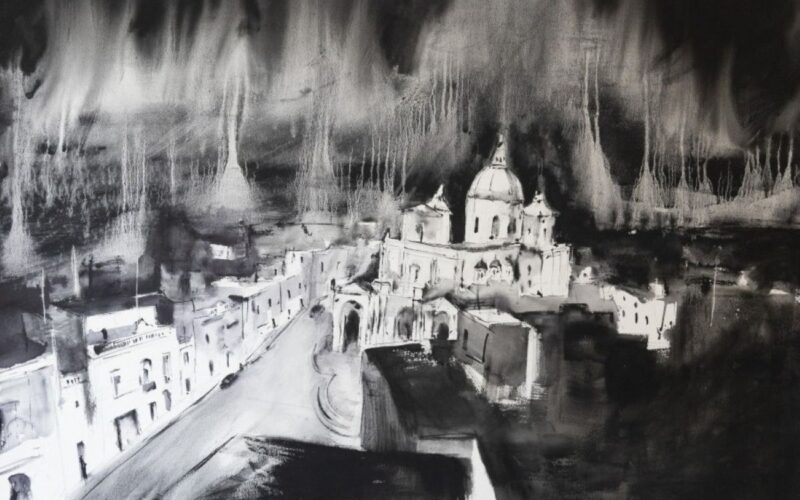Sarah Calleja’s third solo exhibition, ‘Tonal Whispers’, reflects a growing maturity and self-assurance in her artistic voice. Comprising a series of over thirty watercolours, oils, and acrylic paintings executed over the past six years, this body of work invites viewers into a subdued and atmospheric world. What she has managed to capture are introspective landscapes where colour is measured, brushwork is intuitive, and mood reigns supreme. This collection delves into the nuanced realm of ‘tonalism’, capturing subdued compositions through a restricted palette.
From her debut exhibition in 2019 to her second solo in 2022, Calleja has remained faithful to a limited or monochromatic palette, working within a restrained range of tonalities that amplify rather than diminish her expressive potential. This is not an easy feat. Her previous exhibitions had already showcased her ability to convey moods through art, often painting en plein air to capture the immediate atmosphere of a scene. This practice continues in her latest works, where she abstracts scenes into tonal expressions, offering viewers a meditative experience.
One can also observe a clear progression in these works, a subtle yet marked transformation. Whereas her earlier paintings relied on dry brushwork and sharply delineated details, her recent pieces exhibit a newfound fluidity, confidence, and sense of immersion. The brush, once controlled and architectural in its precision, now moves with greater freedom across the surface. The presence of the architect yields to that of the painter, as formerly rigid lines that structured buildings or compositional elements dissolve into washes of colour and nuanced plays of light.
Light, indeed, is central to Calleja’s visual language. It is not merely a source of illumination, but a structuring principle. It is often diffused, occasionally dramatic, and always suggestive. She does not paint scenes as much as she paints sensations. She is not intent on being accurate to what she sees before her. Rather, she wants to capture the soft, silvery quiet of moonlight, the heaviness of a sky before rain, or the haze of a dusky evening.
In this lies her conscious affinity with Tonalism, the late 19th-century art movement originating in the United States that is characterized by its use of subtle colour tones — often greens, purples, blues, and grays — that evoke a sense of calm and introspection. Like James McNeill Whistler, George Inness, and their contemporaries, Calleja privileges mood over detail, seeking to evoke an emotional state through colour, composition, and atmosphere.

Whistler’s Nocturnes in particular find an echo in Calleja’s poetic titles: Celestial Nocturnes, Moonlit Escapes, Ethereal Nights, and Whispers of the Night Sky. These titles convey to the viewer that these paintings are invitations into stillness and atmosphere.
Yet Calleja’s vision is not limited to a monochrome palette. In Sally Port — one of the more colourful works in the exhibition — she allows warmth to enter the palette, infusing the canvas with muted reds, dusky greens, and burnt siennas. The piece remains true to her tonal approach, but the chromatic boldness heightens the emotional temperature.
Sarah Calleja’s Moonlit Path is, on the other hand, a compelling example of her ability to distil emotion and atmosphere into a simple, pared-down visual language. In this work, the viewer is invited into a quietly luminous scene that suggests both solitude and serenity. The composition is restrained and balanced, with a palette limited to dusky blues, colours that evoke the cool hush of nightfall. The titular “path” is barely defined, more suggested than depicted, allowing the eye to wander gently into the depth of the image, as though following a memory rather than a road.
What stands out in Moonlit Path is Calleja’s command of tonal modulation. Light seems to emanate from within the canvas rather than fall upon it. The brushwork is loose and atmospheric, thereby contributing to the work’s dreamlike quality. The influence of Whistler’s Nocturnes is palpable, particularly in Calleja’s interest in liminality, that is, the threshold between night and day, material and immaterial, surface and depth.
Therefore, more than merely portraying landscapes, Calleja’s paintings offer viewers an emotional state that is rendered visible. This reflects Calleja’s continued departure from architectural delineation in favour of mood-driven abstraction, which results in paintings that speak in whispers.
This body of work also reflects Calleja’s growing dedication to her artistic practice. Having devoted more of her time to painting in recent years, her evolution is palpable: in the loosening of her brush, the confidence of her abstraction, and the increasing subtlety with which she deploys tonal variation. There is a clear emphasis on evocation rather than representation. Her landscapes are not topographical: they are psychological. They are not bound to place, but to feeling.

In ‘Tonal Tranquillity’, Calleja offers a sanctuary; what she terms a tonal escape or tonal sanctuary. Her compositions are both fragile and deliberate, whispering rather than declaring, and encouraging slow contemplation. It is a journey through ethereal landscapes, inviting viewers to experience a sanctuary of tones and moods. And one can better immerse oneself in these paintings because of the sheer size of some of them, including two watercolours that are 2 metres long.
This exhibition not only highlights Calleja’s mastery of tonal expression but also allows us to immerse ourselves in landscapes that whisper of serenity and introspection. Through her restricted palette and subdued expressions, Calleja offers a sanctuary for the senses: a place where one can embark on a nocturnal journey through ethereal nights and moonlit escapes.
‘Tonal Tranquillity’ runs from May 9 until May 31 at camilleri paris mode, Rabat.
Article by Charlene Vella










